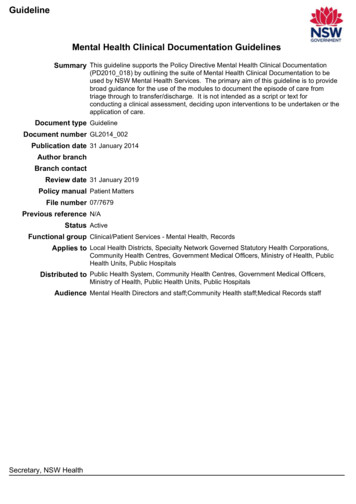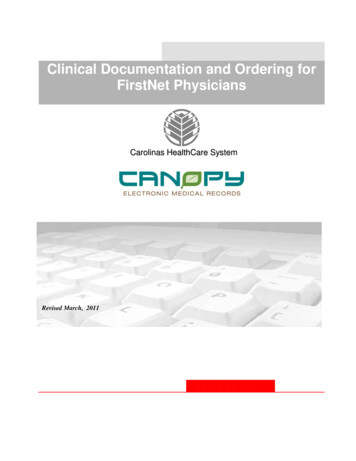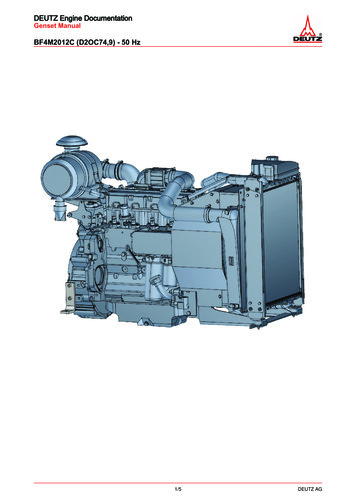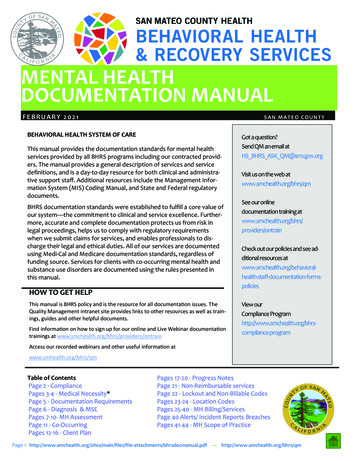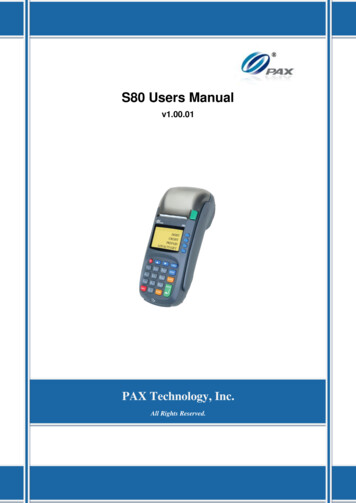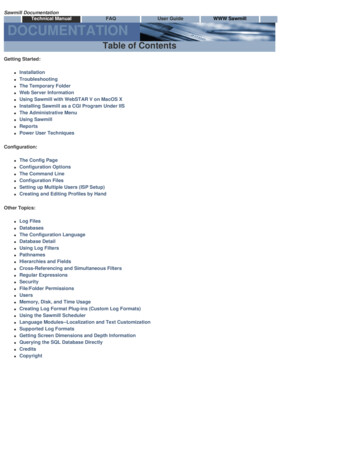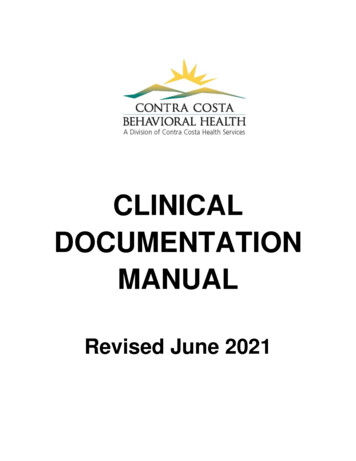
Transcription
CLINICALDOCUMENTATIONMANUALRevised June 2021
TABLE OF CONTENTSCHAPTER 1. INTRODUCTION/COMPLIANCE . 41.1. WHY DO WE HAVE THIS MANUAL? . 41.2.COMPLIANCE . 51.3.UTILIZATION REVIEW . 6CHAPTER 2. GENERAL PRINCIPLES OF DOCUMENTATION AND AUTHORIZATION TIMELINES . 72.1. GENERAL PRINCIPLES OF DOCUMENTATION . 72.2. SIGNATURES . 9CHAPTER 3. ESTABLISHMENT OF MEDICAL NECESSITY . 113.1. THE FLOW OF CLINICAL INFORMATION . 113.2. THE GOLDEN THREAD . 123.3. MEDICAL NECESSITY . 123.4. COMPONENTS OF MEDICAL NECESSITY . 133.2. ASSESSMENT . 15CHAPTER 4. TREATMENT PLANNING . 184.1.PARTNERSHIP PLAN FOR WELLNESS . 184.4. COMPONENT DETAILS AND EXAMPLES . 22CHAPTER 5. UTILIZATION REVIEW TRACK . 295.1. ESTABLISHMENT OF THE UR TRACK/ TIMEFRAMES FOR SUBMISSION OFDOCUMENTATION FOR INITIAL SERVICE AUTHORIZATION . 295.2. ANNUAL RENEWAL OF SERVICES . 30CHAPTER 6. PROGRESS NOTES . 316.1. GENERAL GUIDELINES FOR DOCUMENTING MEDICAL NECESSITY FOR PROGRESSNOTES. 326.2.TIMELINESS OF DOCUMENTATION OF SERVICES . 346.3.FREQUENCY OF DOCUMENTATION . 346.4.PROGRESS NOTE SERVICE DEFINITION . 356.5. DISCHARGE SUMMARY . 446.6. NON-BILLABLE SERVICES . 456.7. LOCKOUTS AND LIMITATIONS . 476.8. SERVICE TYPE COMPARISON . 48CHAPTER 7. SCOPE OF PRACTICE/COMPETENCE/WORK. 53BHSD Clinical Documentation Manual, Rev. June 2021Page 2 of 121
7.1. CCBHS-MHP PROFESSIONAL CLASSIFICATIONS AND LICENSES . 549.1. MEDICATION CONSENTS . 58CHAPTER 9. MEDICATION CONSENTS . 589.2. MEDICATION DOCUMENTATION GUIDELINES . 5810.1. KATIE A. SUBCLASS. 60CHAPTER 10. SPECIAL POPULATIONS. 6010.2. THERAPEUTIC BEHAVIORAL SERVICES (TBS) CLASS . 6111.1. SAMPLE STRENGTHS . 63CHAPTER 11. WORDING SAMPLES . 6311.2. SAMPLE INTERVENTION WORDS . 6311.3. SAMPLE INTERVENTION PHRASES FOR SPECIFIC PSYCHIATRIC SYMPTOMS andCONDITIONS. 6311.4. SAMPLE PROGRESS NOTES . 6711.5. SAMPLE PARTNERSHIP PLAN GOALS . 72APPENDICES . 74APPENDIX A. MEDI-CAL DIAGNOSIS LISTS . 75APPENDIX B. CCBHS-MHP OUTPATIENT INCLUDED DIAGNOSIS LIST . 77APPENDIX C. TITLE 9 SERVICE DEFINITIONS. 87APPENDIX D. SCOPE OF PRACTICE DEFINITIONS. 89APPENDIX E. GUIDELINES FOR SCOPE OF PRACTICE . 110APPENDIX F. ABBREVIATIONS . 112APPENDIX G. FORMS . 121BHSD Clinical Documentation Manual, Rev. June 2021Page 3 of 121
CHAPTER 1. INTRODUCTION/COMPLIANCE1.1. WHY DO WE HAVE THIS MANUAL?This manual was developed as a resource for providers within the Contra Costa Behavioral HealthServices-Mental Health Plan (CCBHS-MHP), which includes County owned and operated programs andCommunity Based Organizations (CBOs). It outlines standards and practices required within theChildren, Youth and Family; Katie A; Forensics; Transitional Services; and Adult & Older Adult systemsof care.CCBHS-MHP establishes documentation standards in order to help realize the commitment to clinicaland service excellence. In addition, accurate and complete documentation protects providers from riskin legal proceedings, helps maintain compliance with all regulatory requirements when claiming forservices, and enables professionals to discharge their legal and ethical duties.CCBHS-MHP submits a claim for each covered service provided by each service provider. All servicesare documented using Medi-Cal Specialty Mental Health documentation rules regardless of the client’sMedi-Cal status. Services for clients with co-occurring mental health and substance use disorders aredocumented using the rules presented in this manual.This manual does not address specific documentation rules for services that are claimed to DrugMedi-Cal Organized Delivery System (ODS) or to Medicare.This Documentation Manual should be considered the CCBHS-MHP standard and is the source for alldocumentation issues. The Utilization Review (UR) Team provides resources as well as trainings, guidesand other helpful documents. UR encourages questions and comments at any time.This manual will be posted at the following -documentation/Updates to this manual are done to address policy and regulation changes. When updates are available,please be sure to replace old sections with updated sections.Sources of informationThis Clinical Documentation Manual is to be used as a reference guide and is not a definitive singlesource of information regarding chart documentation requirements. This manual includes informationbased on the following sources: Code of Federal Regulations (CFR) 45 and 42, the California Code ofRegulations (Title 9 and 22), California Department of Health Care Services (DHCS) Letters andInformation Notices, American Health Information Management Association (AHIMA), Contra CostaCounty policies and procedures, directives & memos; and Quality Improvement & Utilization ReviewDepartment’s interpretation and determination of documentation standards.BHSD Clinical Documentation Manual, Rev. June 2021Page 4 of 121
1.2. COMPLIANCEContra Costa Behavioral Health Services is a county behavioral health organization that providesservices to the community and then seeks reimbursement from state and federal funding sources. Thereare many rules associated with billing the state and federal government, thus the need for thisdocumentation manual. In general, good ethical standards meet nearly all of the requirements. At times,there is a need to provide some guidance and clarity so staff can efficiently and effectively document forthe services they provide.The CCBHS-MHP Utilization Review Unit has adopted a compliance plan that is based on guidance andstandards established by the Office of Inspector General (OIG), US Department of Health and HumanServices. The OIG is primarily responsible for investigations of Medicare and Medicaid fraud andprovides support to the US Attorney’s Office for cases which lead to prosecution. The State of Californiaalso has a Medicaid/Medicare Fraud Control Unit. Many California county behavioral health departmentshave already been investigated by State and Federal agencies; and in all of those counties either severecompliance plans or fraud charges have been implemented.The intent of this compliance plan is to prevent fraud and abuse at all levels. The compliance planparticularly supports the integrity of all health data submissions; as evidenced by accuracy, reliability,validity, and timeliness. As part of this plan we must work to ensure that all services submitted forreimbursement are based on accurate, complete, and timely documentation. It is the responsibility ofevery provider to submit a complete and accurate record of the services they provide and to documentservices in compliance with all applicable laws and regulations.This manual reflects the current requirements for direct services reimbursed by Medi-Cal SpecialtyMental Health Services (Division 1, Title 9, California Code of Regulations (CCR)) and serves as thebasis for all documentation and claiming by CCBHS-MHP, regardless of payer source. All staff in Countyprograms, contracted agencies, and contracted providers are expected to abide by the information foundin this manual.Compliance is accomplished by: Adherence to legal, ethical, code of conduct and best-practice standards for billing anddocumentationParticipation by all providers in proactive training and quality improvement processes.Providers working within their professional scope of practice.Having a Compliance Plan to ensure there is accountability for all CCBHS-MHP, CommunityPrograms activities and functions. This includes the accuracy of progress note documentation bydefined practitioners who will select correct procedure codes and services location to support thedocumentation of services provided.BHSD Clinical Documentation Manual, Rev. June 2021Page 5 of 121
1.3. UTILIZATION REVIEWState regulations and CCBHS-MHP policies specify that all beneficiary health records, regardless offormat (electronic or print), must go through the utilization review (UR) process. This process is meant toensure that all planned clinical services are appropriate to address the client’s behavioral health needs.It is also meant to make sure that the records comply with all State and Federal regulations as well asCCBHS-MHP policies. The Utilization Review process includes the evaluation and improvement ofservices through the following practices: Standing Utilization ReviewContract Provider and or Community Based Organization (CBO) Utilization ReviewInpatient Utilization ReviewMedication Support Services Utilization ReviewUtilization Management/UM has established a Utilization Review Committee (URC) with an aim to reviewhealth records of CCBHS-MHP and its Community Based Organizations. The role of the UR reviewersis critical as they provide clinical oversight and function as a “check and balance” system. The reviewersare CCBHS-MHP Clinical health care professional who has appropriate clinical expertise that canaddress the beneficiary’s behavioral health needs. Reviewers are responsible to ensure the following: All services meet Medical Necessity standards Planned services benefit the client by significantly diminishing the impairment or preventingsignificant deterioration in an important area of life functioning All documents are completed within established CCBHS-MHP standardsReviewers also monitor that client plans are written in client-centered language and include clientsignature as evidence of client involvement. Utilizing a UR tool, reviewers provide feedback to theUtilization Review Manager, who is responsible for tracking any findings, following up on any qualityissues, and identifying items for disallowance.BHSD Clinical Documentation Manual, Rev. June 2021Page 6 of 121
CHAPTER 2. GENERAL PRINCIPLES OF DOCUMENTATIONAND AUTHORIZATION TIMELINES2.1. GENERAL PRINCIPLES OF DOCUMENTATION1.All Providers must refer and adhere to CCBHS-MHPManagement/Utilization Review: Documentation Standards.Policy709-MH,Quality2.All CBOs who currently utilize an Electronic Health Record (EHR) must adhere to the UR SignatureCertification memo of June 1, 2016, regarding EHRs and electronic signatures.3.All Providers must use CCBHS-MHP-approved forms and templates. Contract providers whoutilize an electronic health record system for documentation must incorporate all CCBHS-MHPrequired documentation elements identified in CCBHS-MHP’s Policy 709-MH.4.Required clinical documents, once entered into the medical record, become part of a legaldocument. Therefore, the following are not permitted: removal of pages from the record, erasing oramending notes that have already been entered/filed, and/or destroying the content of the medicalrecord.5.Services can only be entered for billing if there is a corresponding progress note.6.All services shall be provided by staff within the scope of practice of the individual delivering theservice. Licensed clinicians will follow specific scope of practice requirements as determined bythe applicable license regulations of their governing board.7.Each progress note should provide enough detail so that auditors and other service providers caneasily ascertain the service provided, the client’s current status, and needs without having to referto previous progress notes. Each progress note must stand “alone”.8.Each progress note must show that the service met “medical and service necessity” criteria9.Progress notes should clearly indicate the type of service provided and how the service is toaddress an identified area of impairment, and the progress (or lack of progress) in treatment.10.Clinical documentation must incorporate the concept of the “Golden Thread”. The Golden Threadis the documentation that supports each decision, intervention, or client note that contributes to acomplete record of client care that is error free and ready for reimbursement.The Golden Thread begins with the clinical assessment (identified needs), then pulls throughthe treatment plan (interventions and goals) to on-going progress notes (client effort, serviceprovided, progress made towards goals).11.It is crucial that the staff providing the service identify and selects the correct procedure code forthe service provided and that the documentation supports and substantiates this service. Thisensures that CCBHS-MHP receives the correct reimbursement for services provided.BHSD Clinical Documentation Manual, Rev. June 2021Page 7 of 121
12.Some services while necessary for the well-being of the client are not billable to the State. Nonbillable (540) and non-billable lock out (580) codes block a service from being billed. Non-billableservices are meant to include a wide variety of potential services deemed helpful or necessary tothe client but are not reimbursable by the State as a mental health service. These services shouldbe documented by staff working with clients.13.Non-Billable Services Include, but are not limited to: transportation of the client, sending orreceiving a fax, listening to voicemails, leaving voicemails, scheduling appointments, orinterpretation/ translation services.14.NOTE: “Travel” is not “Transportation”.Travel is when a provider travels from their office location to a field location to provide amental health service.Transportation is when a provider drives a client/family member to and from a location.without provision of a mental health service (such as to or from a doctor’s appointment or topick up a check or medication). If a mental health service is provided while transporting aclient, then the time spent providing the mental health service during transportation may bebilled.15.“Elapsed Time” billed should be documented on each progress note. Elapsed time is billed inminutes, and it includes:a.Time spent providing services to the client (i.e., on the phone, face to face, in the field, etc.).b.Documentation time (maximum of 15 minutes is generally considered reasonable).c.Travel time between the work site and the place where services were rendered.16.Please remember to bill for “actual” time spent providing a service to the client. Do not bill “blocksof time” (e.g., an hour for weekly individual therapy sessions).17.Each service contact is documented in a progress note and documentation must be completed ina timely manner. A progress note is completed for each service contact, except for PsychiatricEmergency Services, Crisis Residential Services, and Day Treatment Services.a.PROGRESS NOTE TIMELINE: Progress notes must be completed in a timely manneraccording to the following guidelines:i)Every effort should be made to complete progress notes on the same day of service.ii)Progress notes should be completed within three (3) business days from the deliveryof service.iii)If the progress note is not completed within three (3) business days, the clinician mustwrite “late entry” on the progress note.iv)Please remember, documentation time may not be included in the total time billed if theprogress note was written more than three (3) business days after service delivery.BHSD Clinical Documentation Manual, Rev. June 2021Page 8 of 121
18.For group notes, staff must detail the purpose of the group and individualize the note for each client.Documentation must include how the client benefitted from the group, the client’s participation, andtheir individual response to the interventions provided during the group.19.If a service is provided by multiple staff, each staff is required to complete their own progress notedocumenting their role in the provision of the service and detailing the specific interventions/services they provided.20.Documentation must be legible. Ensure that the spell check function is turned on. Documentationthat is not legible is at risk for disallowance21.APS/CPS Reports, Incident R
to previous progress notes. Each progress note must stand “alone”. 8. Each progress note must show that the service met “medical and service necessity” criteria 9. Progress notes should clearly indicate the type of service provided and how the service is to address an identified area

